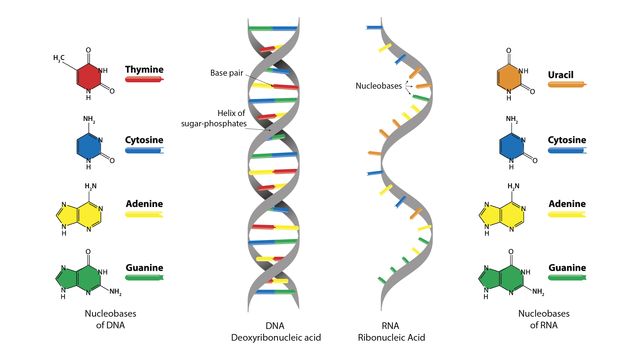Missense, Nonsense and Frameshift Mutations: A Genetic Guide

Complete the form below to unlock access to ALL audio articles.
In the alphabet, different letters can be combined to produce useful and meaningful words – but only if the letters are put together in the "correct" way. The same goes for DNA. Certain nucleotides (the base units of DNA), be it adenine (A), thymine (T), cytosine (C) or guanine (G), can be arranged in a specific manner to form a certain gene, which in turn, encodes a specific protein.
But sometimes biology doesn't stick to the "blueprint plan" when organizing the letters and genetic mutations occur. A genetic mutation is a permanent change to the nucleotide sequence of a gene. More often than not, such genetic mutations are advantageous – they enable evolution and produce new desirable traits in organisms.
However, genetic mutations can also be problematic if they result in a disease. In humans, genetic disorders are often life-limiting and incredibly tricky to treat.
Not all mutations impact the function of the resulting protein. If you want to build a foundational understanding of genomics in both health and disease, it's important to be able to distinguish between the different type of genetic mutations that can occur. Here, we take a look at some of the mutations that can be encountered and the impact they have on the genome.
Note: If you're a little lost here and need to recap, check out our other articles that cover some of the basic principles in genomics.
What is a missense mutation?
A missense mutation occurs when there is a mistake in the DNA code and one of the DNA base pairs is changed, for example, A is swapped for C.This single change means that the DNA now encodes for a different amino acid, known as a substitution. Sometimes a change in the amino acid has no effect on the resulting protein's function at all. On some occasions, the change in amino acid actually enhances the protein's function, but in other cases it can ultimately render the protein as "faulty".
 A visual depiction of a missense mutation.
A visual depiction of a missense mutation.What is a nonsense mutation?
Like a missense mutation, a nonsense mutation also involves a single alteration to the DNA base pair. However, in the case of a nonsense mutation, this single change results in the production of a stop codon, thereby terminating protein synthesis prematurely. The result? A shortened protein that may function, but also may not.
A visual depiction of a nonsense mutation.
What is an insertion mutation?
An insertion mutation involves the addition of one (or more) nucleotide base pairs into the DNA sequence. Insertion mutations can vary in size, ranging from the insertion of just one base pair into the DNA sequence to the insertion of a section of a chromosome into another chromosome. The end result is a potentially malfunctioning protein.
 A visual depiction of an insertion mutation.
A visual depiction of an insertion mutation.What is a deletion mutation?
As the title may suggest, a deletion mutation occurs when there a piece of DNA is removed from the sequence. The size of the DNA that is removed can vary in length, from a single base pair to an entire gene or several consecutive genes. The removal of the DNA can, again, compromise the function of the encoded protein. A visual depiction of a deletion mutation.
A visual depiction of a deletion mutation.What is a frameshift mutation?
A frameshift mutation occurs when the aforementioned "addition" or "deletion" mutations result in a change to the gene's reading frame, which includes groups of three bases that encode for an amino acid. The change in the reading frame alters the grouping of the bases and subsequently changes the amino acids that are encoded. Often, the encoded protein is non-functional.

A visual depiction of a frameshift mutation.
What is a duplication mutation?
In the case of a duplication mutation, a piece of DNA is (abnormally) copied. This might happen once or several times, and can therefore impact the functionality of the encoded protein. A visual depiction of a duplication mutation.
A visual depiction of a duplication mutation.Mutations summary table
| Mutation | Description |
| Missense | Mistake in the DNA code, one of the DNA base pairs is changed |
| Nonsense | Single change in DNA code produces stop codon, prematurely terminates protein synthesis |
| Insertion | Addition of one (or more) nucleotide base pairs into the DNA sequence |
| Deletion | A piece of DNA is removed from the sequence |
| Frameshift | Addition or deletion mutation results in a change to a gene's reading frame |
| Duplication | DNA is abnormally copied |




